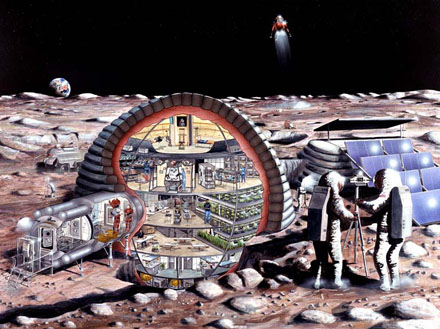Designing a moon Base

A renewed interest in the moon has been sparked by a recent announcement
by the US President to send Americans to Mars and to establishing an extended
presence on the moon.
Construction of structures on the moon will challenge our thinking and
ingenuity. The main problem will not be gravity but how to maintain an
Earth like environment. Since the Moon has no atmosphere the challenge
will be to create a sealed and pressurised living environment with the
right mix true of gases. In fact the living and working chambers will
not be buildings, as we are accustomed to here on Earth, but rather like
pressure chambers. Loads on the walls of such structures will be immense
as the internal pressure will be applying a stress on the external walls
and the leakage of essential gas an ever present problem.
We must also offer the inhabitants protection from the dangers of UV radiation and the constant threat of meteorite impact. Creating a shield for the moon base will add weight to the supporting structures and will offset the benefit of a low gravitational forces. It is estimated the rock two meters in depth will offer enough protection from radiation.
A self-sufficient moon colony is essential for further space exploration. According to investigations of lunar samples, the moon contains deposits of the elements iron (Fe), manganese (Mn), magnesium (Mg), and titanium in the form of ilmenite (FeTiO3). Ilmenite can also be the source of life sustaining oxygen.
Obtaining energy for the self-sufficient
base should not be a problem as there is an area at the pole where it
is almost permanently bathed in sunshine. Solar energy can therefore be
captured by carefully placing solar panels at the pole. Oxygen and water
are necessary to sustain a closed ecological life support system. Oxygen
can be obtained by the chemical processes involved in purifying metals
form the lunar soil. For each person we need a daily amount of 0.6 kg
of food, 0.85 kg of oxygen and 29litres of water. Lets assume that we
can find water on the moon we then require cultivated land of around 20
m2 for each person in order to produce the required daily amount
of food.
This scenario presents us with some logistical problems. Design a moon
base either on paper or by creating a model. In your design show how you
have accounted for:
-transportation ot people and material in the external environment,
-recycling, purification
and storage of air, water, wastes, supplies and energy,
-food production,
-water availability,
-power generation;
-pressurised atmosphere,
-radiation and meteorite protection,
-food production,
-recreation,
-recycling of waste,
-health effect from low gravity and low air pressure.
Click to read a helpful link.
Sourced from https://www.youtube.com/watch?v=O7JtOokh4PU10.03 am 22/10/20
What do you think is the main difference between building a structure on Earth and building it on the moon?
Engineers concede that any long-term habitat on the moon will be in some way buried by piling regolith on the structures or in mineshafts.Why is this necessary?
Every science fiction story has moon bases essentially on the surface formed from glass domes. Why is such a structure so impractical?